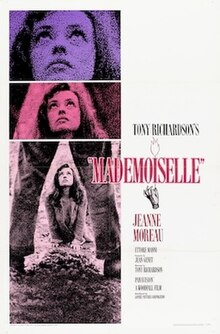Mademoiselle (1966 film)
| Mademoiselle | |
|---|---|
 Theatrical release poster | |
| Directed by | Tony Richardson |
| Written by | Marguerite Duras Jean Genet |
| Produced by | Oscar Lewenstein |
| Starring | Jeanne Moreau Ettore Manni |
| Cinematography | David Watkin |
| Edited by | Sophie Coussein Anthony Gibbs |
| Music by | Antoine Duhamel |
Production company | |
| Distributed by | United Artists[1] |
Release dates |
|
Running time | 105 minutes |
| Countries | France United Kingdom |
| Languages | French Italian |
| Box office | $575,000[2] |
Mademoiselle is a 1966 drama film directed by Tony Richardson. The dark drama won both a BAFTA award and nomination and was featured in the 2007 Brooklyn Academy of Music French film retrospective. Jeanne Moreau plays an undetected sociopath, arsonist and poisoner, a relative newcomer but nevertheless respected unmarried schoolteacher and sécretaire at the Mairie in a small French village.
Synopsis[edit]
As the film begins, Mademoiselle is shown opening floodgates to inundate the village, so there's never a moment in the film that the audience believes she's a normal upstanding citizen, as the villagers do. Later, she sets fire to houses, which she has also seemingly done before the film starts, and poisons the drinking trough, causing the death of farm animals. She has no cause for revenge, and acquires no material gain or increased standing in the community from her crimes. Her capacity for pure malice is suggested when she crushes a wild bird's eggs after it leaves its nest and when she attends the disasters she causes, watching intently as the villagers try to rescue property and animals.
Out of prejudice against a foreigner and outsider, the villagers suspect an Italian seasonal woodcutter, the promiscuous widower Manou (played in Italian by Ettore Manni) of the crimes, even though he has alibis for some of them and has risked his life in salvaging items from the fires. Mademoiselle defends Manou to the police, but persecutes his son in her class.
Sexual tension arises between Mademoiselle and Manou after she begins loitering around him in the woods where he works. They spend the night indulging in somewhat perverse intimacy in the fields while some of the villagers search for him with a view to extracting a confession. In the morning, she returns to the village and allows others, deliberately or otherwise, to infer from her dishevelled appearance that Manou has sexually assaulted her. The villagers find him and beat him to death; his body is not found.
In the final scene, as Mademoiselle is leaving the village for good, it is made obvious that the woodcutter's son, who is also leaving, knows the truth.
Cast[edit]
- Jeanne Moreau – Mademoiselle
- Ettore Manni – Manou
- Keith Skinner – Bruno
- Umberto Orsini – Antonio
- Georges Aubert – René
- Jane Beretta – Annette (as Jane Berretta)
- Paul Barge – Young Policeman
- Pierre Collet – Marcel
- Gérard Darrieu – Boulet
- Jean Gras – Roger
- Gabriel Gobin – Police Sergeant
- Rosine Luguet – Lisa
- Antoine Marin – Armand
- Georges Douking – The Priest
- Jacques Monod – Mayor
Production[edit]
Filming[edit]
The film was shot on location in and around the tiny village of Le Rat, in the Corrèze département of central France. The entire production team stayed in what accommodation they could find locally for the duration of the shoot.
Casting[edit]
The director always saw Jeanne Moreau as the lead. He originally wanted Marlon Brando for the male lead, but scheduling could not be arranged.
Release[edit]
Home media[edit]
The film was released on VHS and DVD by MGM Home Entertainment in the United States in 1994 and 2002 respectively.
Awards[edit]
1967 - Won: BAFTA award for Best Costume Design in B&W [British] (Costume designer Jocelyn Rickards won).
1968 - Nominated: BAFTA Film Award: BAFTA Best British Cinematography (B/W) (Cinematographer David Watkin nominated).
The film was entered into the 1966 Cannes Film Festival.[3]
References[edit]
- ^ "Mademoiselle (1966)". BBFC. Retrieved 1 October 2023.
- ^ Tino Balio, United Artists: The Company That Changed the Film Industry, University of Wisconsin Press, 1987 p. 246
- ^ "Festival de Cannes: Mademoiselle". festival-cannes.com. Retrieved 8 March 2009.
External links[edit]
- 1966 films
- 1966 romantic drama films
- 1960s English-language films
- 1960s British films
- 1960s French films
- British black-and-white films
- British independent films
- British drama films
- French independent films
- French drama films
- BAFTA winners (films)
- Films directed by Tony Richardson
- Films scored by Antoine Duhamel
